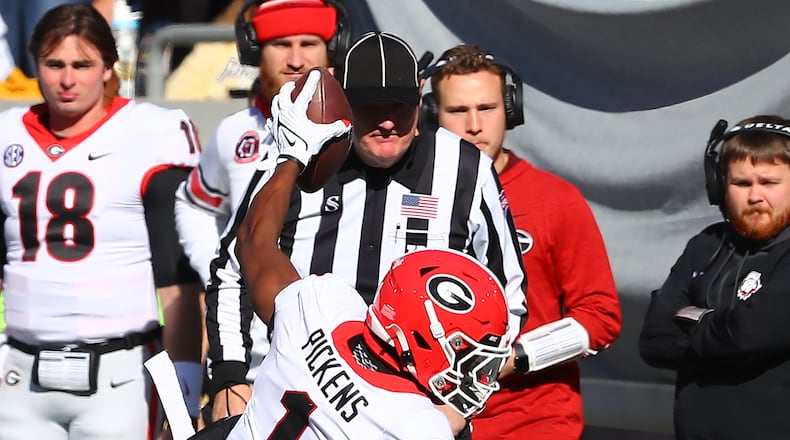ATHENS – “I think that there’s a chance he’s back in 2021.”
Georgia coach Kirby Smart said that on March 25th. That was two days after wide receiver George Pickens went down on the fourth day of spring practice with a torn anterior cruciate ligament in his right knee.
Two hundred and 49 days later – or about 8¼ months – Pickens played against Georgia Tech Saturday. He was on the field for a handful of plays in the regular-season finale and caught one pass for a 5-yard gain in Georgia’s 45-0 win over the Yellow Jackets.
Credit: UGA Athletics
Credit: UGA Athletics
When Pickens trotted out onto the Georgia’s Tech’s Grant Field, the well-represented Georgia crowd took notice and roared in approval.
The thinking now is that Pickens can play even more when the No. 1-ranked Bulldogs face No. 3 Alabama in the SEC Championship game on Saturday in Mercedes-Benz Stadium (4 p.m., CBS).
“I thought it meant a lot for him to hear that,” Bulldogs coach Kirby Smart said. “… It meant a lot for him to go out there and gain some confidence.”
The thinking now is that Pickens can play even more when the No. 1-ranked Bulldogs face No. 3 Alabama in the SEC Championship game on Saturday in Mercedes-Benz Stadium (4 p.m., CBS). While Dr. James Andrews, who performed Pickens’ reconstructive surgery, and Smart might’ve thought that was a possibility, few others did.
Credit: The Mayo Clinic
Credit: The Mayo Clinic
The normal recovery time for an ACL reconstruction (nine to 12 months) projected Pickens’ return for the end of the calendar year. And then, there were Pickens’ pro prospects to consider.
As Georgia’s leading receiver each of the last two years, the junior from Hoover, Ala., was projected as a possible first-round NFL draft pick following last season. Surely, Pickens wouldn’t risk a potential financial windfall to play two or three more games in college.
But pro ball never was Pickens’ foremost concern, his coaches and teammates say.
“The people that thought he was just going to rehab and go to the league don’t know George at all,” quarterback Stetson Bennett said. “It’s kind of funny to hear those people talk because they don’t know how much he loves football and loves his teammates and how hard he’s attacked every day, rehab-wise, to get back to play with us -- not to go to the NFL. He’s going to do what he’s going to do and he’s going to have a long career like he is. So, I’m happy for him. I know how hard he’s worked to get that knee right and how difficult it’s been for him. And he’s done that job pretty well.”
According to a 2019 article in AL.com, Dr. James Andrews, the world-renown orthopedic surgeon who performed Pickens' reconstructive surgery, is now using stem cells and blood plasma to accelerate the recovery process from ACL injuries. Such treatments can speed up recovery by three or four months, according to the report.
The two keys to Pickens’ quick return are his dedicated and aggressive attitude toward rehab and the person who performed the surgery.
Andrews, a world-renown orthopedic surgeon from Birmingham, Ala., is known for getting high-profile athletes back into competitive form in short order. The best example was in 2012, when then-Minnesota Vikings running back Adrian Peterson returned to the field for the season opener just eight months after tearing his ACL and MCL the previous December.
Not only did Peterson play in every game that season, he wound up winning league MVP and was a mere nine yards short of breaking the NFL single-season rushing record.
That was then.
According to a 2019 article in AL.com, Andrews is now using stem cells and blood plasma to accelerate the recovery process from ACL injuries. Such treatments can speed up recovery by three or four months, according to the report.
At this point, it’s not known whether stem-cell or blood-plasma treatments were incorporated into Pickens’ treatment. But clearly he has exceeded expectations for his return to competition.
It was thought in March that Pickens might be able to get back on the field for the College Football Playoffs or a bowl game. That he was cleared before the regular-season finale is stunning.
Smart credits the quick return to Pickens attacking his daily rehabilitation regimen under the supervision of Ron Courson, Georgia’s director of sports medicine.
“I’m just proud of the work that George has put in to get back,” Smart said. “We’ve known guys on the team who have had ACLs. It’s a mental injury as much as it is a physical injury. It’s taxing. It’s draining to sit there and watch all your friends go out and play in the spring, play in the spring game, play in the fall, and you’re sitting there doing rehab all the time. But George loves football, he’s always wanted to get back and have the opportunity to get out there.”
The question now is how receivers coach Cortez Hankton handles the Bulldogs’ receiver rotation heading into the conference championship matchup against Alabama. Georgia has a pretty good setup as it is. Led by tight end Brock Bowers (37 receptions, 652 yards, 10 TDs) and wideouts Ladd McConkey (36-395-4), A.D. Mitchell (24-334-2) and Jermaine Burton (20-376-4), the Bulldogs’ receivers seem to have a good rhythm going with Bennett and Georgia’s quarterbacks.
But the 6-foot-3, 200-pound Pickens’ team-leading 85 catches and 14 TDs over the last two seasons suggest he might be able to give the Bulldogs’ something they’ve been missing.
“He’s a great player,” Bennett said. “We’ve got to get some of the chemistry back that comes with being out that long. But he was extremely happy to be back on the field and we’re all happy to have him.”
Meanwhile, Smart warns that the Pickens we’re seeing now is not necessarily the receiver we watched the last two seasons nor the one he will be with more time to recover.
“He hasn’t really been cleared for contact until the end of this past week,” Smart said. “… He’s safe and he’s cleared, but he’s not 100 percent right now. He’s got the knee brace on and I think he’s pushing that. But we’re proud of the GPS numbers he’s hit.”
Anything the Bulldogs are getting from Pickens now seems like a bonus.
Dawg Tags: The AJC presents a daily look at the one thing you need to know about Georgia athletics today.
About the Author
Keep Reading
The Latest
Featured



